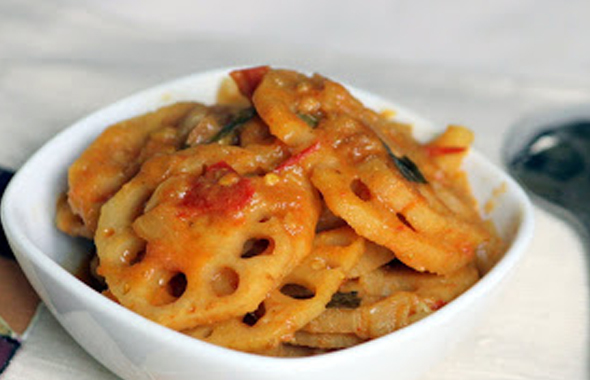Mama’s Punjabi Recipes – Bhaen ki Sukki Sabzi(Sauteed Lotus Root)
The dish of bhaen (lotus root) is probably unique to the Punjab; in some places it is also known as kamal di dandi. In India, the vegetable is available during most parts of the year and can be made dry – as in this recipe – or curried. These days, in India, you can even find snackbags of fried spicy thin lotus root chips.
The lotus is a divine symbol in Hinduism and many other Asian cultures, representing purity and non-attachment. Vishnu and Lakshmi are often portrayed on a pink lotus, and the Goddess Sarasvati is portrayed on a white lotus. Ganga and Ganesh are also often depicted with lotus flowers as their seats. In politics, the BJP uses the lotus as its symbol and in the civilian award Padma Sri, the word Padma means lotus.
The lotus root is found underwater and can grow to a length of four feet. It is reddish brown with a white interior that is lacey, and has a texture that is slightly crunchy and mildly sweet. The lotus root is rich in dietary fiber, vitamin C, potassium, thiamin. Riboflavin, vitamin B5, phosphorus, copper and manganese and is low in saturated fat. The Indian variety is smaller and tastier than the Chinese variety which is bigger but also more porous and less crunchy which makes the dish come out slightly mushier.
This recipe is for stuffed lotus root but can be modified for sliced lotus root in which case you do not have to boil the pieces but simply sauté them in the karai (wok). Some people cook the roots in the pressure cooker, but I have found that this unnecessary and you also risk overcooking and getting a very tender, mushy dish that falls apart. I will share the recipe for curried lotus root later.
Ingredients:
• 500 gm bhaen (lotus roots)
• ¼ cup tael (olive oil or vegetable oil)
• Filling masala mix: 1 tsp namak (salt), 1 tsp mirch (red peper), 1 tsp amchoor (green mango powder), ½ tsp haldi (turmeric powder), 2 tsp dhania (coriander powder), ½ tsp garam masala
Ingredients for curry masala:
• 1 large pyaaz (onion) – peeled and chopped
• 4 cloves of lasan (garlic) peeled and chopped
• 1 medium adrak (ginger)- peeled and chopped
• 1 medium tamater (tomato) – chopped or 1 teaspoon tomato paste
• ½ cup water
Directions:
1. Cut off the ends of each stalk and with a potato peeler, peel the outer skin of the lotus root. Cut into two-inch long pieces and rinse thoroughly in cold water to clean out any clumps of dirt that are trapped within the tubular areas.
2. Place the pieces in a pot of cold water and bring to a boil. When the lotus root pieces are a little tender, turn the heat off and drain the water. Let the pieces sit for a little while to cool down.
3. Take each piece and cut a slit lengthwise but not too deep and set aside.
4. In a small bowl, combine the ingredients for the masala mix; then take a pinch and stuff the mix into the slits and set the filled pieces aside.
5. Heat the oil in a karai or wok and add the curry masala spices and water except the tomato and brown it a little. When roasted and the smell of the pieces starts to come through, add the chopped tomato and brown a little more till it becomes a paste. Be careful not to overcook or dry the paste out.
6. Now add the stuffed pieces of lotus root. Stir carefully to coat the pieces, cover and cook over low heat for ten minutes. Do not open the cover as the lotus root will cook in its own steam. Stirring gently occasionally to make sure the curry masala does not stick or start to burn.
7. When the pieces are tender, turn the heat off and let it sit covered for ten minutes. This goes well with hot rotis, but it since it is a dry dish, another dish with curry sauce makes a good complement.
Shakuntla Malhotra is a skilled cook of Punjabi dishes made in the old-fashioned style that she learnt as a young woman in her ancestral home in Lyallpur, India before it became part of Pakistan after the Partition in 1947. People have often admired her cooking for its simplicity and taste that comes with each mouthful. Even in her mid-eighties, she continues to cook daily and agreed to share some of her delectable Punjabi recipes.


